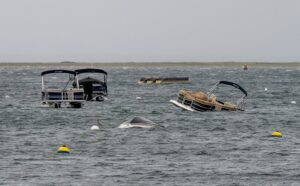PROVINCETOWN — As the sun crept over Provincetown Harbor, Capt. Mike Rathgeber was at the dock, getting ready for another day on the water. He packed the boat, checked his gear, and gave the forecast one last look as he prepared to sail to Race Point.

“Seventy-five degrees, southwest winds, five to ten knots: beautiful,” he said. “I even told Tammy, my mate, ‘We’re going to have a great trip.’ ”
But the wind on June 11 had other plans. It came around to the southeast and east — and winds from those directions funnel directly into the bay with nothing to slow them down, Rathgeber said.
“It blew probably 25, and we got our asses kicked,” he said. “Had I known that beforehand, I probably would have adjusted where I fished.”
Rathgeber is not alone in being confounded by inaccurate weather forecasts. Malcolm Hunter, the dockmaster at Flyer’s Boatyard, said that nine boats took a beating there after a morning report inaccurately forecast the storm that blew through on May 22.
“They forecasted correctly the strength of the wind, but they forecasted incorrectly the direction of the wind,” he said. “We ended up basically having a southeasterly wind direction from a nor’easterly gale, and that is why it took such a toll on the boats.”
These kinds of surprises have become more common, locals say — not because the weather is getting stranger but because forecasts are getting shakier.
It does not help that the Outer Cape’s unique geographical configuration poses special problems for predicting the weather, according to Wellfleet resident and meteorologist Doug Blewitt. The narrow peninsula’s shape and chaotic atmospheric conditions complicate an already intricate process.
“I’ve been in a situation with the sea breeze where I’m getting a north-northeast wind in Provincetown,” Blewitt said. “And then if I get down to Truro, where the arm of the Cape goes around, now the Cape is running north-south; the wind shifts to east.
“And this is over maybe a couple of miles,” he added. “That makes forecasting very difficult in this unique water-land environment hanging out in the middle of the North Atlantic.”
Then there is the fact that the National Weather Service — the main forecasting arm of the National Oceanic and Atmospheric Administration and the source of most data used by broadcasters and private weather companies — controls only one weather station in the area, the automated weather observing system at the Provincetown Municipal Airport.
Don’t expect improvements anytime soon. In fact, experts are warning that weather forecasting accuracy may severely decline because the National Weather Service has lost nearly 600 employees following federal funding cuts.
Backyard Inputs
Although it may still be too early to see the effects of staffing shortfalls on forecasting accuracy, fishermen in Provincetown say they are already beginning to note more errors than usual, said Mike Packard, a local lobster diver who was briefly engulfed by a whale in 2021 before being spit out.
“My wife will say, ‘Oh, it’s gonna rain for the next five days,’ ” Packard said. “And then it’s sunny and beautiful.”
That kind of discrepancy, experts say, stems less from human misjudgment and more from how weather is modeled on the Outer Cape.
For Truro, Wellfleet, and Eastham, forecasters rely not on direct readings but complex computer algorithms. Phil Burt, the amateur meteorologist who founded Cape Cod Weather and also writes for the Independent, said that these models interpolate conditions for the Outer Cape using data obtained from satellites, weather stations, and buoys.
“It’s getting fed in constantly,” Burt said, referring to the output from weather sensors. “Then there’s a series of mathematical equations that look at all the data and try and produce forecasts.”
But what goes into those models can be iffy.
“Most of the federal weather observations are primarily at airports,” said Matthew Belk, a lead meteorologist for the National Weather Service in Boston. “And not too many people live at airports.
“We try to fill in some of the gaps with these backyard weather stations,” he added.
Most personal stations are connected to online networks like Weather Underground, which uploads data on local conditions to the public in real time, Belk said. Forecasters at the weather service then choose to feed data from personal weather stations into their larger algorithms.
Here on the Cape, too, residents have taken matters into their own hands, mounting wind sensors on rooftops, logging readings from back yards, and sharing it all online, where the data can then be accessed by NOAA. With the federal government operating only one official weather station in Provincetown, forecasters are increasingly turning to these unofficial data sets, according to Belk.
But the backyard observations do not always yield reliable data. Ari Preston, an atmospheric sciences professor at Vermont State University, said the placement of personal weather stations has an outsize effect on their readings — and decisions to plant them behind buildings or other structures can be detrimental to their accuracy.
“There’s a reason we invest good money in robust professional-grade instruments,” Preston said. “Accuracy does matter, and we can’t necessarily fill in these data gaps with readings from private citizens.”
Dan Holdaway, data assimilation chief for NOAA’s Environmental Modeling Center, told the Independent that only “the highest quality PWS observations will be used” by his agency. And “all observations have to pass several layers of rigorous quality control,” he said, though he did not provide details on what those checks entail.
Now, with staffing shortages at the National Weather Service, quality control processes may be among the first things to go, according to Jeffrey Basara, a professor at UMass Lowell.
“Bad data in is not going to be helpful,” he said. “That’s one of the big challenges right now. Even if you have a great model, if it’s not getting good information, it doesn’t necessarily have the ability to produce great forecasts.”
Those data issues may already be showing up in the numbers. While NOAA models in the past generally predicted wind speed within a few knots, their forecasts were off on average by as much as 20 degrees in May, according to a statement from Dana Strom, task lead at NOAA’s Meteorological Development Lab. With few significant precipitation events that month, there wasn’t enough data to fully evaluate rain forecasts, either.
Hurricane Season Ahead
Even as locals grow frustrated with busted forecasts and experts warning of strained systems, the weather service maintains that it’s holding the line. Despite major funding cuts, National Weather Service spokesperson Erica Cei wrote in a statement that the agency “continues to meet its core missions amid recent reorganization efforts.
“Additionally, a targeted number of permanent, mission-critical field positions will soon be advertised under an exception to the Department-wide hiring freeze to further stabilize frontline operations,” she wrote.
With hurricane season heating up, some scientists warn that cracks in the system may soon become impossible to ignore as increasingly frequent and severe storms begin to put the agency’s capabilities to the test.
“We’re going to get a much better sense of what is happening with forecast accuracy as we move into the hurricane season,” Preston, the Vermont State professor, said. “We are expecting an above average hurricane season for this upcoming fall.”
Alan Sealls, president-elect of the American Meteorological Society, said that while he thinks staffing shortages may negatively affect local forecasts in areas like the Outer Cape in the short term, he is more concerned about what the cuts will mean for long-term improvement in weather models.
In the past, he said, despite sometimes frustrating misses, forecasting steadily improved over time.
The issue now, he said, is whether that trajectory will continue. “Down the line,” he said, “things will come up short because, literally, people are focusing on different things.”



